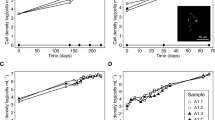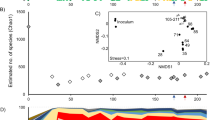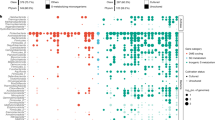Abstract
IN the dilution method of counting Desulphovibrio in soil or water, a selective medium containing lactate and inorganic salts is commonly employed. The growth of a sulphate reducer is recognized by the appearance of the black colour of ferrous sulphide. Since the organisms are anaerobes and the medium is simple in composition the addition of a reducing agent is essential. Grossman and Postgate1 selected cysteine as the most suitable of the reducing substances they examined. Cysteine possesses the disadvantage that it may be attacked with the liberation of sulphide by certain bacteria which do not reduce sulphate. Hence it is necessary to apply some test to confirm the presence of Desulphovibrio in cultures which become black. A further disadvantage in the method proposed by Grossman and Postgate is that the cultures are incubated in an anaerobic atmosphere.
This is a preview of subscription content, access via your institution
Access options
Subscribe to this journal
Receive 51 print issues and online access
$199.00 per year
only $3.90 per issue
Buy this article
- Purchase on SpringerLink
- Instant access to full article PDF
Prices may be subject to local taxes which are calculated during checkout
Similar content being viewed by others
References
Grossman, J. P., and Postgate, J. R., Proc. Soc. App. Bact., 16, 1 (1953).
Starkey, R. L., and Wight, K. M., “Anaerobic Corrosion of Iron in Soil” (Amer. Gas Assoc., New York, 1945).
Starkey, R. L., J. Amer. Wat. Wks. Assoc., 40, 1291 (1948).
Author information
Authors and Affiliations
Rights and permissions
About this article
Cite this article
ABD-EL-MALEK, Y., RIZK, S. Counting of Sulphate-reducing Bacteria in Mixed Bacterial Populations. Nature 182, 538 (1958). https://doi.org/10.1038/182538a0
Issue date:
DOI: https://doi.org/10.1038/182538a0
This article is cited by
-
Fluorometric detection of sulfate-reducing bacteria via the aggregation-induced emission of glutathione-gold(I) complexes
Microchimica Acta (2019)
-
Effect of the Addition of Zero Valent Iron (Fe0) on the Batch Biological Sulphate Reduction Using Grass Cellulose as Carbon Source
Applied Biochemistry and Biotechnology (2013)
-
Elemental sulfur of bacterial origin in the lacustrine evaporites of the Polatli-Sivrihisar Neogene Basin (Central Anatolia, Turkey)
Carbonates and Evaporites (2006)
-
Elemental sulfur formation related to celestine reduction: An example of biomineralization of bacterial origin
Carbonates and Evaporites (1999)
-
Metabolic diversity in epibiotic microflora associated with the Pompeii wormsAlvinella pompejana andA. caudata (Polychaetae: Annelida) from deep-sea hydrothermal vents
Marine Biology (1990)



